Award-winning photojournalist and media trainer Frank Folwell shares secrets to nabbing the perfect photograph.
Citizen journalists learned his tips during a bootcamp in Egypt organized by ICFJ Anywhere called "The Use of Digital Tools in Public Service Journalism."
These are some of Folwell's tips.
-
Memory and power. Make sure you have enough storage space and battery power on your camera or phone to cover an event. Extra batteries (external power for the iPhone) and storage media are a must. Be prepared.
-
Get close, fill the frame. Place the subject in the foreground. Watch backgrounds – make sure they improve the picture, not distract.
-
What to include or exclude. “What should I include in the picture? What is important to tell the story?” Consider what to exclude. What is distracting? Telephone poles, signs, cars. Compose to keep them out of the picture. There are exceptions. You might want to show a specific location through photos of car license plates or road signs. In that case, these objects can be important.
-
Zoom lens. Learn what the zoom can do. For portraits use a medium zoom. When you want to show surroundings, use the wide angle with the subject in the foreground. The telephoto can help fill the frame and isolate subjects.
-
Shutter delay. When you push the shutter in most digital cameras there is a delay as the camera focuses and if using flash, waiting for it to charge. Control this by pushing the shutter half way to lock the focus. Then, compose the picture and push the button all the way to take the picture.
-
Focus. Push button half way and lock the focus on the object you want. You can change the composition once you lock the focus.
-
Natural light. When possible, avoid using flash. In most cases flash looks unnatural. Indirect light coming through a window can work well for indoor pictures during the day.
-
Great light helps make great pictures. Try to avoid shooting outdoors at midday. Early morning or late afternoon light is warmer and provides much nicer modeling. Try to photograph so the sunlight provides maximum texture and detail. This occurs when the sun is to the left or right of the camera. In most cases avoid photographing with the sun behind you or directly in front of you.
-
Look for different camera angles – move around. Get low to clean up a background or include a tall building. Look around for a higher elevation. For overall scenes, a high angle may provide excellent perspective.
-
Keep shooting. Take plenty of pictures – experiment - and learn to edit tightly.
- Practice. Be familiar with your equipment so you can work confidently. Fumbling with your camera will cause you to miss the moment and gives the impression you are not professional.

